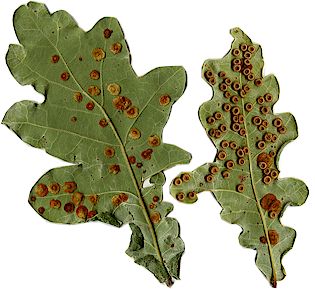BACK TO ..
..

The Study of Galls is known as Cecidology
Galls can be caused by fungus, bacteria, mite, fly, midge, moth, wasp or beetle larvae. The plant species can have several different gall species on different parts of the plant - leaves, twigs, buds, roots, flowers and catkins, often each caused by a different agent and occasionally a gall can appear on another gall!

Nail Galls on Lime
CLICK IMAGES TO FIND OUT MORE
Key ....Wasp / Sawfly......Mite.....Fungi......Nematode ......Fungi......Bacteria
|
|
|
|
| Oak Quercus |
|
A Gall Wasp Neuroterus quercusbaccarum |
| Oak Quercus | A Gall Wasp Neuroterus numismalis | |
| Oak Quercus |
Knopper Gall |
Gall WaspAndricus quercuscalicis |
| Oak Quercus | Gall Wasp Andricus kollari | |
| Oak Quercus |
Currant Gall - : on underside of oak leaves. |
Gall Wasp (Sexual) Andricus quercusbaccarum |
| Oak Quercus | A Wasp Biorhiza pallida | |
| Oak Sessile or Pedumculate | Acorn Cup galls Wasp Andricus grossulariae | |
| Oak Sessile or Pedumculate | Cola Nut Galls
|
Gall Wasp Andricus lignicola |
A Wasp Cypnips divisa
|
||
| Sessile Oak | |
Gall Wasp Andricus fecundator |
| Ash | Mite Eriophyes fraxinivorus | |
| Birch | Witches Broom Gall | Fungi Taphrina betulina |
| Aspens | Galls of : Aspen | |
| Willows | Pea Like Red Gall | Pontania viminalis |
| A Sawfly
Pontania proxima |
||
| Alder
|
Alder Tongue |
A Fungal Plant Pathogen Taphrina alni |
| Alder
Alnus glutinosa |
|
Gall Mite
Eriophyes
laevis |
Roses |
|
A Cypnid Wasp Diplolepis rosae |
| Dog Rose |  |
Gall Wasp Diplolepis eglanteriae/nervosa |
| Spiked pea galls | Diplolepis nervosa | |
| Bramble | Bramble Gall Wasp | Wasp Diastrophus rubi |
| Common Lime | A Mite Eriophyes tiliae | |
| Nettle | Nettle Clustercup Rust Puccinia urtica | |
Meadow Sweet |
A Rust
Triphragmium ulmariae |
|
|
|
What is a " Gall " ?
Abnormal outgrowth on a plant that develops as a result of attack by insects or, less commonly, by bacteria, fungi, mites, or nematodes. The attack causes an increase in the number of cells or an enlargement of existing cells in the plant. Gall-forming insects generally pass the early stages of their life inside the gall.
...
..
Fig 1 & 2 Chambers within the Gall Containing the large developing Grub of the Cynip Wasp Diplopsis rosae
Gall wasps are responsible for the conspicuous bud galls forming on oak trees, 2.5–4 cm/1–1.5 in across, known as ‘oak apples’. The organisms that cause galls are host-specific. Thus, for example, gall wasps tend to parasitize oaks, and sawflies willows.
The ensuing "Gall" also becomes home for an elaborate ecosysyem in itself with other wasps often involved capitalising on the "fruits of the Gall" known as inquilants.These other species of wasp larvae will make use of the gall. There are the species that do not form their own galls but just utilize those already formed by others, these are the inquilines
Galls are relatively common however they are not often noticed and because of this only a few have common names, manyspecies are known only by their scientific name.
The Common and Silk Button Spangle Gall are found on our common Oak (Quercus robur). They are produced by a tiny Cynipid wasp which goes through a complicated life cycle using two stages of development.
Things begin in June when a generation of both Male & Female wasps hatch from Currant Galls. The adults mate and the female lays fertilized eggs on the underside of the Oak leaves. These cause the creation of the Common Spangle Gall in which the grub matures. The Spangle Galls fall from the leaves in September and the wasp continues to grow within the leaf litter. In April they hatch to produce a female-only generation. These start the cycle again by laying eggs on Oak flowers which develop into the Currant Galls.
Other species of Cynipid wasps produce different kinds of gall and have different life cycles. One example is the Knopper Gall which uses two different species of Oak (Quercus robur & Quercus cerris) and two years to complete its cycle.
English Oaks can have > 56 species living on them, including the Marble gall ( These are caused by a wasp called Andricus kollari, while the illustrations below shows three different spangle galls on the underside of oak leaves.




LAST UPDATED 04-Jan-2015 3:53 PM
Links
British Plant Gall Society BPGS
Galls on Aspen - A first look Article
Galls Galls
Photos Of Inects Photos Of Insects in section Common Galls Common Galls
University of Kentucky Galls
Waynes World On galls Waynes World
Gall Cornell University FAQS
Galls and Rusts NotesArticle Gall Making Insects and Mites Article
Image Rich Gallery on Gall Wasp Images and Gall Wasp Videos













